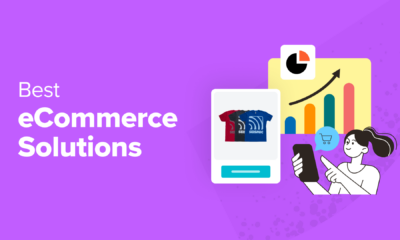AFFILIATE MARKETING
Site Traffic Down? Google Just Made Some Big Search Changes

Google is now doing the Googling for its expansive U.S. audience — and news publishers are facing potentially multi-billion-dollar consequences caused by the change.
Google announced on Tuesday that it is applying AI to high-impact elements of search, from AI summaries to pages of AI recommendations in clustered groups. AI summaries, which appear at the top of search results and neatly summarize content found across the web, started rolling out on Tuesday to all of Google’s 246 million unique U.S. users.
The AI summaries mean that websites across the board will get less traffic, as people simply search and read what the AI has generated without clicking on anything.
As newsrooms get less traffic and less money, their ability to create fresh content diminishes. At the same time, Google becomes less of a gateway to sources and more of a direct source Anastasia Kotsiubynska, Head of SEO at SE Ranking, shared with Entrepreneur.
“Most likely, there will still be misleading information in search results and hallucinations, and many users will probably use this information without double-checking,” Kotsiubynska cautioned.
Google I/O 2024 on May 14, 2024. (Photo by Christoph Dernbach/picture alliance via Getty Images)
Google’s search changes could cost websites $2 billion collectively; some could lose two-thirds of their traffic, according to data from media industry growth company Raptive.
“This will be catastrophic to our traffic, as marketed by Google to further satisfy user queries, leaving even less incentive to click through so that we can monetize our content,” Danielle Coffey, the chief executive of the News/Media Alliance, told CNN Business.
This is Search in the Gemini era. #GoogleIO pic.twitter.com/JxldNjbqyn
— Google (@Google) May 14, 2024
Google, a major tech company with over 90% of the global market share in search, can now frame search results however it wants with AI summaries, and pull from websites without guaranteeing site traffic or profit.
Related: Two Yale PhDs Are Trying to Make AI Hallucinate 10x Less
“AI Overviews relies on content creators’ intellectual property, which raises serious questions about compensation and fairness,” said Raptive in a statement.
Google does link to sites within its summary, citing its sources.
Unlike OpenAI, which has entered into deals with major publishers like Axel Springer and The Financial Times to compensate publishers for training AI on their articles and linking directly to them, Google has yet to publicly announce a similar deal with a major publication.
OpenAI has also earned the ire of some publishers, with the New York Times filing a lawsuit against the company over copyright grounds in December.
Google does have a $60 million deal with Reddit, announced in February, to train its AI on Reddit data.
AFFILIATE MARKETING
Cut Costs, Not Features with This Microsoft Bundle Deal

Disclosure: Our goal is to feature products and services that we think you’ll find interesting and useful. If you purchase them, Entrepreneur may get a small share of the revenue from the sale from our commerce partners.
Software subscription fees can quickly add up, and for small-business owners, entrepreneurs, or freelancers, these costs can eat into profits. Businesses spend approximately 29% of their IT budgets on software, according to a 2023 survey by Gartner.
For business professionals who are looking to streamline workflow without paying steep subscription fees, the Ultimate 2019 Microsoft Bundle might be the perfect solution. For just $71.94 (regularly $927), this comprehensive four-part bundle offers Microsoft Office Professional Plus 2019, Windows 11 Pro, Project 2019, and Visio 2019.
While it’s not the newest version of Microsoft’s software, it can deliver tremendous value for anyone seeking tools to manage their business, boost productivity, and work efficiently. The bundle offers a lifetime license, meaning you’ll get all the functionality you need without the recurring costs associated with subscription services like Microsoft 365.
However, it does come with Windows 11 Pro, which includes the recent AI updates. Windows 11 Pro delivers a modern, intuitive interface with enhanced security features such as biometric login and Smart App Control, making it ideal for professionals who prioritize privacy and usability. It’s also equipped with tools that support multitasking, such as Snap Layouts and Virtual Desktops.
For companies looking to reduce overhead without compromising essential functionality, making a one-time purchase of slightly older software is a smart financial move. This includes Office’s most popular productivity tools, Word, Excel, PowerPoint, and Outlook.
Project 2019 is a must-have for anyone who is managing large or small projects. It helps track tasks, timelines, and resources, making it easier to stay on top of deadlines and ensure your team moves in the right direction. Project 2019 gives you the tools to streamline processes and manage tasks efficiently.
Visio 2019 is ideal for creating professional diagrams, flowcharts, and organizational charts. It’s particularly valuable for visualizing complex data or workflows, which is essential for business owners looking to improve operational efficiency.
If you need a productivity boost without eating into savings, take a closer look at this bundle.
Get the Ultimate 2019 Microsoft Bundle with Office, Project, Visio, and Windows 11 Pro for $71.94 (regularly $927).
StackSocial prices subject to change.
AFFILIATE MARKETING
3 Trends That Will Change the Future of Entrepreneurship

Opinions expressed by Entrepreneur contributors are their own.
The most recent data from the new Global Entrepreneurship Monitor report reveals a powerful trend for the future of entrepreneurship.
Young adults, aged 18-24, had both the highest entrepreneurial activity and entrepreneurial intentions in the United States, according to the Global Entrepreneurship Monitor 2023-2024 United States Report. With similar results in 2022, this is not just a minor shift — it’s a fundamental change that could have lasting impacts on the economy and society.
I serve as the chair of the board for the Global Entrepreneurship Research Association, the entity that oversees GEM, which was founded in 1999 as a joint venture of Babson College and the London Business School. As the GEM U.S. team co-leader and a professor of entrepreneurship at Babson, I see firsthand the impact of the research created by the Global Entrepreneurship Monitor.
Here are three entrepreneurship trends from the new GEM report that are changing the landscape for the future.
Related: 21 Success Tips for Young and Aspiring Entrepreneurs
1. Young entrepreneurs on the rise
For years, entrepreneurship has been dominated by older, more experienced individuals, but this year’s report shows that the youngest adults are now at the forefront. According to GEM, 24% of 18- to 24-year-olds are engaged in some form of entrepreneurial activity, a higher rate than any other age group. What’s driving these young entrepreneurs is equally remarkable: They aren’t just starting businesses to make money; many are deeply committed to making a positive impact on society and the environment.
These young entrepreneurs make sustainability a key priority. They are more likely than entrepreneurs from older generations to build businesses with sustainability as a core focus — whether that means reducing their environmental footprint or focusing on social causes. This shift toward impact-driven entrepreneurship isn’t just anecdotal. GEM data shows a significant number of young entrepreneurs taking real, measurable steps to create businesses that align with their values. With sustainability as their north star, young entrepreneurs appear to be simultaneously pursuing societal impact as well as profits.
However, it’s not all smooth sailing. While young people are leading the way in starting businesses, they are also discontinuing them at higher rates than their older counterparts. The discontinuation rate for 18- to 24-year-olds is 15%, the highest among all age groups. This is not surprising, given the challenges of inexperience and more limited access to capital. Starting a business is tough, and sustaining one is even more challenging. But despite these hurdles, the enthusiasm and energy that young people bring to entrepreneurship are undeniable, and with the right support, this generation has the potential to drive substantial change.
2. Tech gender gap narrows
One of the most promising findings in the GEM report is the narrowing gender gap in the technology sector. Historically, tech startups have been dominated by men, but 2023 saw a record-low difference in the number of men and women starting tech companies. The gap has narrowed to just 1%, with 8% of women compared with 9% of men launching businesses in the Information and Communication Technology (ICT) sector.
This is a significant step forward and reflects broader efforts to support more women technology startups. Still, it’s important to recognize that while progress is being made, continued focus on providing equal opportunities is essential to ensuring this trend continues.
3. Optimistic outlook for Black and Hispanic entrepreneurs
Another highlight from the report is the optimistic outlook among Black and Hispanic entrepreneurs. These groups showed stronger confidence in their entrepreneurial abilities and lower fear of failure compared to their white counterparts. Black respondents, in particular, demonstrated high levels of resilience and self-assurance, which is vital in overcoming barriers faced in starting and sustaining businesses. This optimism is encouraging, but there’s still much work to be done in assuring ecosystems offer equal opportunities for all aspiring entrepreneurs, regardless of their background.
Related: I Wish I Received This Advice as a Young Entrepreneur
A promising future
Reflecting on the key findings of this year’s GEM report, it’s clear that the entrepreneurial landscape is changing in meaningful ways. The rise of young, sustainability-driven entrepreneurs signals a future where business is not only about profit but also about making a difference. These young entrepreneurs are launching businesses at a time when the world is looking for solutions to some of its most pressing challenges — climate change, poverty and economic recovery.
Yet, to fully realize the potential of this next generation, there must be more focus on addressing the challenges they encounter. Young entrepreneurs need access to the right resources — whether it’s funding, education or mentorship — to turn their innovative ideas into sustainable businesses. The narrowing gender gap in tech is encouraging, but we must continue to foster environments that support women and other underrepresented groups in entrepreneurship.
The GEM report paints a picture of an entrepreneurial future driven by purpose, diversity and innovation. But it also reminds us of the work that lies ahead in making entrepreneurship more accessible and sustainable. If we can provide young entrepreneurs with the tools and support they need, we will not only see more businesses being created — we’ll see businesses that are making a lasting, positive impact on the world.
AFFILIATE MARKETING
These Are the Top Side Hustles to Work Less, Make More Money

In the best-case scenario, a side hustle could turn into a multimillion-dollar business that generates a passive income stream — but at the very least, starting a side gig could help pay some bills.
A new survey from personal finance software company Quicken shows that almost half (43%) of Americans with a side hustle, or an extra source of income added to a primary income, make more money and clock in fewer hours overall than those without a side hustle.
The three most popular side hustles pursued by those who work less and make more money were personal assistance (20%), cooking and baking (16%), and caregiving (16%). One in five people with side hustles said they were business owners, too, selling products online or offering services like photography.
The majority of people with side hustles (82%) said starting a side gig helped them financially, and kept them from living paycheck to paycheck. Most with side hustles (57%) had savings equal to at least four months of living expenses.
The survey also found that, for younger side hustlers, a way to an extra income doubles as a path to becoming more employable. 44% of Gen Z (born between 1997 and 2012) choose to start a side hustle in order to obtain skills for long-term careers, much higher than the overall 18% of Americans who started a side hustle with the same motivation.
Quicken conducted the survey online, gathering responses from more than 1,000 Americans.
Additional research on side hustles, released in August by NEXT Insurance, showed that three out of five people bring in less than $1,000 monthly in side income, while 22% make $1,000 to $10,000 a month, and 15% make more than $10,000.
Related: Starting a Side Hustle Should Come With a Warning Label — Here’s What You Need to Know
-

 WORDPRESS6 days ago
WORDPRESS6 days agoThe Ultimate WordPress Toolkit for Pros (59+ Must-Have Tools)
-
SEARCHENGINES6 days ago
Daily Search Forum Recap: October 25, 2024
-

 WORDPRESS6 days ago
WORDPRESS6 days agoHostinger Review: Website Creation Made Easy
-

 SEARCHENGINES5 days ago
SEARCHENGINES5 days agoGoogle Ranking Movement, Sitelinks Search Box Going Away, Gen-AI In Bing & Google, Ad News & More
-

 AI1 day ago
AI1 day agoHow AI is Transforming SEO and What Website Owners Need to Know
-

 WORDPRESS7 days ago
WORDPRESS7 days ago11 Best eCommerce Solutions Growing in Popularity in 2024
-

 SEO6 days ago
SEO6 days agoAll the best things about Ahrefs Evolve 2024
-

 WORDPRESS5 days ago
WORDPRESS5 days ago5 Most Profitable Online Businesses You Can Start Today for Free!












